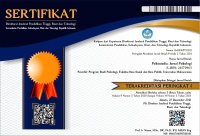How Mothers of Children With Autism Spectrum Disorder Think About Their Quality of Life?
Abstract
Raising a child with autism spectrum disorder (ASD) can be challenging for mothers in many ways, their quality of life: social, physical, psychological, etc. This research explored how mothers with ASD perceive their quality of life and what influences those perceptions. This study employed qualitative research design. A total of 3 mothers were participated, using convenience sampling method in Bandung, West Java. This study using a semi-structured interview with a prepared guideline by the researchers, based on strong framework and theory. A method called content analysis was used to systematically understand the challenges they faced, the coping mechanisms they developed, and finally, the factors they believed would improve their quality of life. The data were analyzed using the content analysis approach. The participants reported a variety of difficulties and their way of coping with the problems, following factors that could help them to raise their quality of life. Results reported into 5 themes, following with 13 sub-themes. The main themes included “challenges”, “fears about the future”, “changes in social interactions”, “happiness & gratitude” and “factors to improve QOL”.
Hidup berdampingan dengan anak autism spectrum disorder (ASD) dapat memberikan beberapa dampak negatif pada orang tua termasuk kualitas hidup mereka yang terdiri atas aspek sosial, fisik, psikologis, dll. Penelitian ini bertujuan untuk mengidentifikasi persepi orang tua terkait kualitas hidup yang dimiliki serta hal yang melatarbelakanginya. Penelitian ini menggunakan desain penelitian kualitatif dan teknik convenience sampling. Sebanyak 3 orang tua dari Bandung, Jawa Barat berberpartisipasi dalam penelitian ini. Guna mengumpulkan data, penelitian ini menggunakan semi-structured interview dengan panduan yang telah disusun berdasarkan teori. Selanjutnya, data di analisis menggunakan pendekatan content analysis. Hasilnya diperoleh bahwa Ibumerasakan beberapa kesulitan dan upaya menghadapinya diikuti dengan beberapa faktor yang dapat membantu Ibu meningkatkan kualitas hidupnya. Hasil dari penelitian ini dikelompokkan kedalam 5 tema utama, diikuti dengan 13 sub-tema. Tema utama terdiri atas “tantangan”, “ketakutan tentang masa depan”, “perubahan dalam interaksi sosial”, “kebahagiaan & rasa syukur” dan “faktor untuk meningkatkan QOL”.
Keywords
Full Text:
FULL TEXTReferences
Aman, M. G. (2004). Management of hyperactivity and other acting-out problems in patients with autism spectrum disorder. Seminars in Pediatric Neurology, 11(3), 225–228.
Amiri Majd M, Hosseini SF, Jafari A. (2014). Comparing the quality of life and marital intimacy among parents of children with Down syndrome, parents of children with learning disabilities, and parents of normal children. J Learn Disabilities, 4:38‑55.
Bromley, J., Hare, D. J., Davison, K., & Emerson, E. (2004). Mothers supporting children with autistic spectrum disorders social support, mental health status and satisfaction with services. Autism, 8(4), 409–423.
Chen, Jennifer, et al. “Parents’ Future Visions for Their Autistic Transition-Age Youth: Hopes and Expectations.” Autism, vol. 23, no. 6, 2018, pp. 1363–1372, https://doi.org/10.1177/1362361318812141.
Couturier, J. L., Speechley, K. N., Steele, M., Norman, R., Stringer, B., & Nicolson, R. (2005). Parental perception of sleep problems in children of normal intelligence with pervasive developmental disorders: Prevalence, severity, and pattern. Journal of the American Academy of Child and Adolescent Psychiatry, 44(8), 815–822.
Crane, Laura, et al. “Parents’ Views and Experiences of Talking about Autism with Their Children.” Autism, vol. 23, no. 8, 2019, pp. 1969–1981, https://doi.org/10.1177/1362361319836257
Downe-Wambolt,B. (1992). Content analysis: method, applications and issues. Health Care for Women International, 13, 313–321.
Faraji‑Khiavi F, Zahiri M, Amiri E, Dindamal B, Pirani N. (2021). The experiences of families raising autistic children: A phenomenological study. J Educ Health Promot, 10:78.
Gentles SJ, Nicholas DB, Jack SM, McKibbon KA, Szatmari P. (2020). Coming to understand the child has autism: A process illustrating parents’ evolving readiness for engaging in care, 24:470‑83.
Graneheim UH, Lundman B. (2004). Qualitative content analysis in nursing research: concepts, procedures and measures to achieve trustworthiness. Nurse Educ Today. 24(2):105-12. Doi: 10.1016/j.nedt.2003.10.001. PMID: 14769454.
Gurney, J. G., McPheeters, M. L., & Davis, M. M. (2006). Parental report of health conditions and health care use among children with and without autism: National survey of children’s health. Archives of Pediatrics and Adolescent Medicine, 160(8), 825.
Kamali M, Ostadhashemi L, Khalvati M, Nourozi S, Nafei A. (2013). Quality of life of the physically disabled: A systematic review. Pajouhan Sci J, 12:27‑35.
Khanna, R., Madhavan, S. S., Smith, M. J., Patrick, J. H., Tworek, C., & Becker-Cottrill, B. (2011). Assessment of health-related quality of life among primary caregivers of children with autism spectrum disorders. Journal of Autism and Developmental Disorders, 41(9), 1214–1227.
Klukowski M, Wasilewska J, Lebensztejn D. (2015). Sleep and gastrointestinal disturbances in autism spectrum disorder in children. Dev Period Med, 19:157‑61.
Kuhlthau, K., Hill, K. S., Yucel, R., & Perrin, J. M. (2005). The financial burden for families of children with special health care needs. Maternal and Child Health Journal, 9(2), 207–218.
Kuhlthau, K., Kahn, R., Hill, K. S., Gnanasekaran, S., & Ettner, S. L. (2010a). The well-being of parental caregivers of children with activity limitations. Maternal and Child Health Journal, 14(2), 155–163.
Kuhlthau, K., Kovacs, E. A., Hall, T., Clemmons, T., Orlich, F., Delahaye, J., et al. (2013). Health-related quality of life for children with ASD: Associations with behavioral characteristics.
Research in Autism Spectrum Disorders, 7(9), 1035–1042.
Kuhlthau, K., Orlich, F., Hall, T. A., Sikora, D., Kovacs, E. A., Delahaye, J., et al. (2010b). Health-related quality of life in children with autism spectrum disorders: Results from the autism treatment network. Journal of Autism and Developmental Disorders, 40(6), 721–729.
Ludlow, Amanda, et al. (2011). “Challenges Faced by Parents of Children Diagnosed with Autism Spectrum Disorder.” Journal of Health Psychology, vol. 17, no. 5, pp. 702–711, https://doi.org/10.1177/1359105311422955.
Matson JL, Kozlowski AM. (2011). The increasing prevalence of autism spectrum disorders. Res Autism Spectr Disord, 5:418‑25.
Maenner MJ, Warren Z, Williams AR, et al. (2023). Prevalence and Characteristics of Autism Spectrum Disorder Among Children Aged 8 Years — Autism and Developmental Disabilities Monitoring Network, 11 Sites, United States, 2020. MMWR Surveill Summ, 72(No. SS-2):1–14. DOI: http://dx.doi.org/10.15585/mmwr.ss7202a1
McStay RL, Dissanayake C, Scheeren A, Koot HM, Begeer S. (2014). Parenting stress and autism: The role of age, autism severity, quality of life and problem behavior of children and adolescents with autism. Autism, 18:502‑10.
Mirzaie H, Jamshidian E, Hosseini SA. (2018). Routines in families of children with Autism. Arch Rehabil, 19:184‑93.
Mosadeghrad AM, Pourreza A, Akbarpour N. (2019). Economic burden of autism spectrum disorders in Iran. Tehran Univ Med J, 76:665‑71.
Renford NG, Arulappan J, Thomas KD, Karuppiah KM, Chinnathambi K, Thangaswamy GC. (2020). Quality of life of caregivers of children with autism spectrum disorder in Tamil Nadu, South India. Int J Nutr Pharmacol Neurol Dis, 10:57‑64.
Scott EK. (2018). Mother‑ready jobs: Employment that works for mothers of children with disabilities. J Fam Issues, 39:2659‑84.
Strock, M. (2007). Autism spectrum disorders (pervasive developmental disorders). Bethesda: National Institute of Mental Health (NIMH).
Woodgate, Roberta L., et al. (2008). “Living in a World of Our Own: The Experience of Parents Who Have a Child with Autism.” Qualitative Health Research, vol. 18, no. 8, pp. 1075–1083, https://doi.org/10.1177/1049732308320112.
DOI: http://dx.doi.org/10.30872/psikostudia.v13i2.14507
Refbacks
- There are currently no refbacks.
Copyright (c) 2024 Ersa Zefanya & Fredrick Dermawan Purba

This work is licensed under a Creative Commons Attribution-ShareAlike 4.0 International License.
Psikostudia: Jurnal Psikologi is indexed by :
PSIKOSTUDIA: Jurnal Psikologi Published by Faculty of Social and Political Siences, University of Mulawarman, Samarinda, East Kalimantan and This work is licensed under a Creative Commons Attribution-ShareAlike 4.0 International License.
_________________________________________
PSIKOSTUDIA: Jurnal Psikologi
Department of Psychology
Faculty of Social and Political Siences, University of Mulawarman
Jl. Muara Muntai Kampus Gn. Kelua Samarinda 75411
Phone: +62 813 35350368
E-Mail: psikostudia@fisip.unmul.ac.id




















